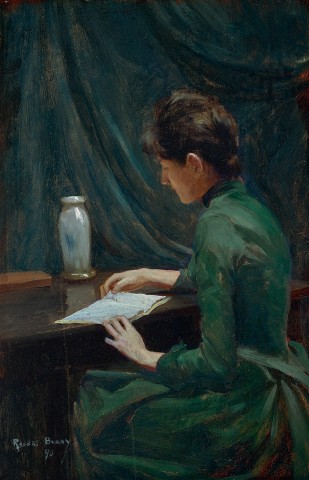THE ARTIST'S SISTER ANNETTE, 1890
RUPERT BUNNY
oil on panel
25.0 x 16.0 cm
signed and dated lower left: RUPERT BUNNY / 90
Private collection, United Kingdom
Christie’s, London, 29 May 1984, lot 142 (as ‘A Young Lady Reading at a Table’)
Tom Silver Fine Art, Sydney
Gould Galleries, Melbourne
Private collection, Melbourne, acquired from the above in 1999
69 John Street, Sydney
Private collection, Sydney
Collectors Exhibition: Important Australian Artists 1830 – 1940, Tom Silver Fine Art, Melbourne, 31 March – 21 April 1985, cat. 35 (illus., as ‘Portrait of a Young Woman Reading’)
Traditional, Modern and Contemporary Fine Art, 69 John St, Sydney, 11 April – 2 May 2014, cat. 5 (illus. in exhibition catalogue, as ‘The Artist's Sister Hilda Reading’, label attached verso)
Thomas, D., The Life and Art of Rupert Bunny, A Catalogue Raisonné in Two Volumes, Thames & Hudson, Melbourne, 2017, Volume 1: p.16, Volume 2: cat. O25, pp. 52 (illus.), 53, 286
Annette Bunny (1862-1949), known as ‘Nettie’, was Rupert Bunny’s closest sister and a favourite model during his early years. Possibly his first portrait, Portrait of a Lady, c.1885 (private collection, Sydney) is of Annette. Others followed, including those of her daughters Ethel and Hilda. His finest group portrait, Portrait of Mrs Herbert Jones and Her Daughters, c.1904 (private collection, Sydney) was painted at her home, ‘The Priory’, Huntington, England, where Bunny was a frequent visitor. The Artist’s Sister Annette, 1890 is also thought to have been painted there during a visit from Paris. The occasion was important. Joined by their mother, Marie Bunny and youngest sister Hilda, they were visiting from Australia following the tragically early death of Annette’s husband Walter Coote. Significantly, it is one of a very few paintings Bunny dated, most having family connections.
Of the seven Bunny sons and daughters, Annette was born on 26 January 1862 and Rupert on 29 September 1864. Their Australian home was ‘Eckerberg’ in the Melbourne suburb of St. Kilda until Annette married the Englishman Walter Coote in1881 and settled in England. Later, when Rupert travelled to Europe with his father, Brice Bunny, and stayed on in England to study art, the Cootes kept a friendly family watch, giving Rupert much support. A joint Annette-Rupert sketchbook of c.1884-6 bears witness to their mutual interest, sketching together outdoors as they did in those years.1
Coote gained international fame through his travels, having twice ventured around the world and exploring in particular, Melanesia. His subsequent books were highly acclaimed, for example, The Western Pacific: Being Descriptive of the Groups of Islands of the North and East of the Australian Continent, published in London in 1883 and illustrated with engravings from the author’s sketches. A member of the Royal Geographical Society, Coote eventually gave his collection of native weapons and ornaments to the British Museum.2
Support for Bunny continued throughout Annette’s second marriage to the wealthy brewer Herbert Jones in August 1892. His wedding present was Bunny’s painting, Les Roses de Sainte-Dorothée, 1892 (Bunny’s mother’s third name was ‘Dorothea’). Jones took an active role in the political life of the county; and when mayor of Huntington in 1901, he commissioned Bunny to paint a portrait of Edward George Henry, 8th Earl of Sandwich, which he presented to the Corporation of Huntington. A keen sportsman, Jones was a regular follower of the Fitzwilliam Hounds, Annette being a fearless huntswoman who relished the thrill of the jump.3
The Artist’s Sister Annette, 1890 presents a striking image of Nettie profiled against heavy, dark curtains. Emphasis is given to what she is doing through the highlighting of hands and document. What she is reading is tantalisingly unknown. Strong in character, the composition shows Bunny’s early mastery of the play of light across dress and figure. Within a year he painted another dated work of Annette, the bust Portrait of Mrs Walter Coote, 1891 (private collection, London). Profiled in the Italian Quattrocento tradition, her face line is even more effectively rendered set against the plainest of backgrounds. And again, a lively Mrs Herbert Jones in Sketch was probably painted in 1892, the year of her second marriage. Bunny, warmly acknowledged in the academies and salons of London, Paris, Budapest and elsewhere, became one of Australia’s most internationally distinguished artists of his age. His brilliant portraits of the great and gifted include Madame Melba, c.1902 (National Gallery of Victoria, Melbourne) and Percy Grainger, c.1902 (Grainger Museum, The University of Melbourne).
1. Nanette Coote/Rupert Bunny Sketchbook, The University of Melbourne Art Collection (1948.36)
2. ‘Walter Coote obituary’, The Hunts County Guardian, 29 March 1890, p. 8
3. ‘H. C. Jones obituary’, The Huntingdonshire Post, 21 November 1935, p. 9
DAVID THOMAS
